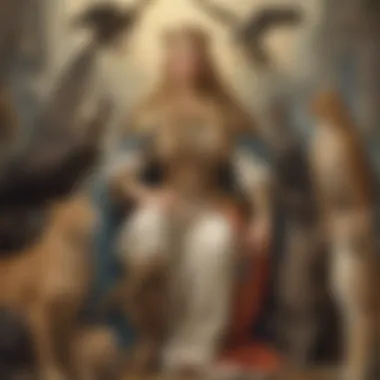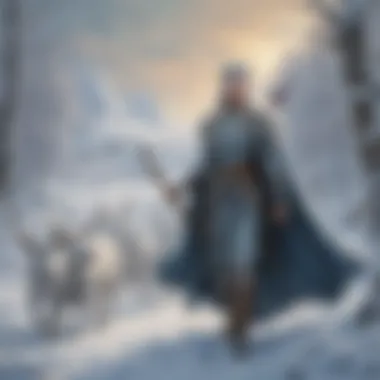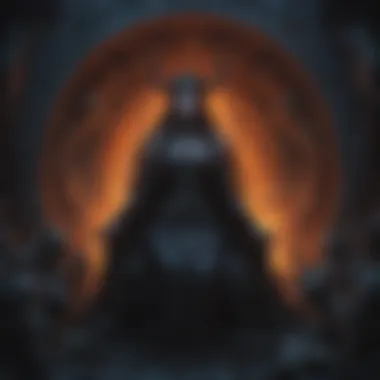Exploring the Pantheon of Norse Goddesses


Intro
Norse mythology presents a captivating tapestry of ancient narratives, threading through the lives of gods, goddesses, and legendary beings. Among its key figures, the goddesses play pivotal roles, shaping both divine and mortal realms. This article seeks to dissect the significance of these formidable women, illuminating their attributes and exploring their representation in modern culture.
From the wisdom of Frigg to the warrior spirit of Freyja, each goddess embodies unique characteristics that reflect the values and beliefs of the Norse people. By delving into their historical contexts and examining their influences, we can understand how these goddesses continue to resonate with contemporary society.
As we embark on this exploration, the aim is to provide a nuanced understanding of the goddesses' roles in mythology and their lasting legacy.
Norse Goddesses and Their Attributes
The complexity of Norse goddesses reveals much about the culture they stem from. Various figures are associated with different aspects of life, death, and nature. Here are some notable goddesses:
- Frigg: Often regarded as the queen of the Aesir, Frigg is known for her wisdom and foresight. She embodies the nurturing aspects of femininity and is central to many myths involving family and relationships.
- Freyja: As a goddess of love and war, Freyja possesses remarkable duality. She is often connected to fertility, beauty, and the cycles of life.
- Hel: The ruler of the underworld, Hel is a lesser-known goddess but vital to the understanding of life after death in Norse beliefs.
Each of these figures plays an essential role in the mythological framework, influencing the narratives and beliefs surrounding the Norse pantheon.
Impact on Scandinavian Culture
The influence of Norse goddesses is profound in Scandinavian cultural heritage. They have been represented in art, literature, and folklore throughout history. Many Swedish, Norwegian, and Danish tales reference these goddesses, showing how their legacies persist in various forms.
"The gods and goddesses of Norse mythology provide insight into the values of ancient Norse people, revealing their understanding of the world and their place within it."
Modern interpretations often draw on these narratives, illustrating their relevance to contemporary discussions of gender, power, and identity. As society evolves, so too does the dialogue surrounding these divine figures.
Enduring Relevance
In recent years, interest in Norse mythology has surged within popular culture. From novels to films, the portrayal of goddesses like Freyja and Frigg reflects both traditional and modern interpretations.
Their portrayal encourages discussions about femininity and strength, making these ancient figures relevant in today’s context. Understanding the narratives of these goddesses also contributes to feminist discourse, providing historical precedence for powerful women throughout time.
Through this examination, the article aims to shed light on the diverse roles and representations of Norse goddesses, enhancing knowledge of this ancient mythology and its contemporary interpretations.
Prelims to Norse Mythology
Norse mythology presents a rich tapestry of beliefs, stories, and characters that offer insight into the values and worldview of the ancient Norse people. In the context of this article, understanding the foundations of Norse mythology provides essential context for exploring the goddesses who play vital roles within this framework. The intricate relationships among these deities, particularly the goddesses, reflect the cultures and ideals of the societies that revered them.
The significance of Norse mythology extends beyond mere stories; it encapsulates beliefs regarding life, death, and the cosmos. Each goddess embodies specific qualities and ideals that the Norse people aspired to, making their narratives deeply relevant to both ancient and modern audiences. Moreover, the Norse pantheon offers a glimpse into the interaction between the divine and the mortal, which is central to understanding the broader implications of these myths.
Overview of Norse Beliefs
Norse beliefs are rooted in a polytheistic worldview where a multitude of gods and goddesses represent different aspects of existence. At the center of these beliefs is the concept of Yggdrasil, the World Tree, which connects all realms of the Norse universe.
Some key elements of Norse beliefs include:
- Cosmic Order: The Norse saw the universe as a series of interconnected realms, such as Asgard (home of the gods), Midgard (home of humans), and Hel (the realm of the dead).
- Fate and Destiny: The Norns, three sisters who govern fate, play a pivotal role in determining the destinies of both gods and humans.
- The Importance of Honor: Concepts of honor and valor are vital. The stories often reflect struggles and the consequences of actions in a morally complex world.
These beliefs play a crucial part in shaping the narratives surrounding the goddesses, making them not just figures of worship but also embodiments of the cultural values held by the Norse people.
Importance of Deities in Norse Culture
Deities in Norse culture were not merely objects of worship; they were integral to the very identity of the people. The gods and goddesses influenced everything from daily life to societal norms. They were believed to have a hand in fertility, weather, war, and even personal relationships, making them highly relevant in various aspects of existence.
In addition to their powers, deities serve crucial functions, such as:
- Moral Guides: Their stories often carried lessons on morality and ethics, teaching devotees how to live with honor.
- Cultural Symbols: Different deities, including the prominent goddesses, symbolize key aspects of life and cultural beliefs—like Freya, representing love and war.
- Community Cohesion: Rituals and stories surrounding these deities fostered a sense of community, bringing people together in shared beliefs and practices.
Overall, the deities' importance in Norse culture highlights their relevance as we explore the many facets of the goddesses in the following sections.
The Role of Goddesses in Norse Mythology
The role of goddesses in Norse mythology is vital for understanding the complex dynamics within this ancient belief system. Norse society was deeply intertwined with its mythology, and the deities acted as reflections of cultural values, socio-political structures, and human experiences. Goddesses held unique positions, often serving as counterparts to their male counterparts, providing a balance between feminine and masculine energies. They were not only divine figures but also symbols that showcased the various aspects and archetypes of femininity.
Their influence extended beyond mere religious worship; they permeated various aspects of daily life, community practices, and even governance. For example, goddesses like Frigg and Freya embodied ideals of motherhood and warrior spirit, respectively, solidifying their significance in both domestic and martial realms. This duality highlights how goddesses shaped relationships, societal roles, and ethical standards throughout Norse culture.
Furthermore, these goddesses represent more than just mythological constructs. They embody teachings about strength, resilience, and the interconnectedness of life. Their stories often intersect with important themes such as sacrifice, love, and the quest for knowledge, making them relatable figures across ages. Analyzing these roles illuminates their manifold contributions to a society that revered its deities as guides and protectors.


"In Norse beliefs, goddesses were integral not just as mythological figures but as embodiments of individual and collective identity."
Divine Feminine Archetypes
In exploring Norse mythology, divine feminine archetypes emerge prominently. These archetypes represent essential characteristics and traits within the pantheon of goddesses. Each goddess symbolizes aspects such as wisdom, love, war, and fertility, contributing to a more holistic understanding of femininity in the Norse context.
Frigg, the mother of the god Odin, epitomizes wisdom and foresight. She is often portrayed as a protective figure, guiding her family and ensuring stability in the cosmos. Freya serves as the goddess of love and war, encapsulating passion and fierce determination. Skadi reinforces the archetype of the independent woman, representing strength and survival skills in the harsh winter landscapes. Each goddess thus illustrates dimensions of femininity that were acknowledged and revered by Norse people.
These archetypes allow for expressions of the divine that resonate with the human experience. They reflect the struggles and triumphs of women, providing models for behavior and attitudes in society. As a result, understanding these archetypes can enhance one's grasp of social norms and values in ancient Norse culture.
Goddesses as Symbols of Power
The significance of goddesses as symbols of power underscores their role in Norse mythology. Beyond their divine status, these figures modeled authority and leadership traits that resonated with followers. They influenced not only spiritual practices but also political and communal decision-making processes.
Goddesses like Freya were not limited to domestic spheres; rather, they engaged actively in conflicts and wars. This portrayal emphasized the strength women could wield in society, challenging norms that relegated them strictly to nurturing roles. Likewise, Sif, the goddess of Earth, symbolizes the power of fertility and agriculture, essential components of sustenance in Norse life. Her representations emphasize the interconnectedness of the land and life force, showcasing how power is pervasive in various forms.
Through various narratives in the Poetic Edda and other texts, goddesses wielded significant influence over mortals and gods alike. They often became pivotal figures in mythological tales, leading to transformations and resolutions that marked their power dynamics. Ultimately, these narratives reinforced the concept that divine feminine energies are potent and vital to the cosmos, making the roles of goddesses in Norse mythology imperative for understanding cultural power structures.
With this exploration, readers can appreciate the unique interplay of strength, wisdom, and authority embodied by Norse goddesses, augmenting their cultural and historical significance.
Major Norse Goddesses
The figure of the goddess holds significant relevance in Norse mythology. These deities represent various aspects of life and existence, from war to love, and from fertility to wisdom. They show the complex interplay between the feminine divine and the societal values of ancient Norse culture. Each goddess possesses unique attributes and stories that enrich our understanding of this mythology. By examining these goddesses, readers can gain insight into how spiritual beliefs shaped daily life in Scandinavian societies.
Frigg: The Mother of Odin
Attributes and Symbolism
Frigg is an essential figure in Norse mythology. As the mother of Odin, she embodies wisdom and foresight. Her attributes often include spinning and weaving, which symbolize the creation of destiny and fate. This connection makes her a compelling choice for understanding divine femininity in Norse lore. The idea of weaving fate showcases Frigg's role in guiding the destinies of gods and mortals alike. Her attributes enrich the narrative of Norse mythology by illustrating how the divine interacts with human lives
Stories and Myths
In Norse stories, Frigg often appears as a protective mother. Her myths frequently involve her attempts to safeguard her son, Baldur, who is fated to die. This highlights the tension between fate and free will, making her stories important for grasping broader Norse beliefs. Frigg's narratives teach about love, loss, and the inevitability of fate, inviting deeper reflections on human experience.
Historical Depictions
Historically, Frigg has been depicted in various artifacts, such as carvings and rune stones. These show her as a strong figure who commands respect among both gods and mortals. Such representations help to solidify her status within Norse society, illustrating the high regard that existed for divine motherhood. These depictions also depict the importance of familial ties within the pantheon, underscoring the interconnectedness of divine relationships in mythology.
Freya: The Goddess of Love and War
Role in Valkyrie Lore
Freya is a multifaceted goddess known for her duality in love and battle. As a commander of the Valkyries, who choose the slain in battle, she plays a crucial role in the afterlife. This aspect of her character makes her vital for discussions about valor and femininity in warfare. Freya’s ability to navigate both love and war reflects the balance of power inherent in Norse culture. The Valkyries, as her maidens, also symbolize the recognition of women's roles in shaping destiny.
Associated Symbols
Freya has several associated symbols, like the falcon and the necklace Brísingamen. These are not merely decorative; they carry deep meanings. The falcon symbolizes freedom and transcendence, while Brísingamen reflects divine beauty and love. Together, these symbols enrich the portrayal of Freya, raising questions about beauty's connection to power in Norse beliefs.
Cultural Influence
Freya's influence extends beyond ancient times into literature and pop culture. She often appears in modern adaptations, reflecting themes of empowerment and strength. Her character resonates with contemporary audiences, demonstrating the lasting impact of Norse goddesses in shaping cultural narratives around female power. By examining Freya, readers can explore how ancient myths continue to inspire discussions on femininity today.
Skadi: The Goddess of Winter
Significance of the Hunt
Skadi represents the harshness of winter, but she also symbolizes the primordial struggle for survival. Her association with hunting demonstrates the deep connection between Norse culture and their environment. As a huntress, she represents independence and strength, showing that women were not merely passive figures but active participants in sustenance and survival. This notion makes her a significant figure in understanding gender roles in Norse society.
Mythological Narratives
Skadi's mythological narratives often involve her quest for vengeance. She seeks to avenge her father's death, eventually choosing a husband through a contest. This personal story sheds light on themes of revenge and choice, illustrating how societal values shaped personal actions. Skadi’s narratives offer insights into the values that defined bravery and justice within Norse culture.
Modern Representations
Today, Skadi appears in various media, including video games and literature. These contemporary portrayals often highlight her as a fierce and independent character. By engaging with her in modern contexts, audiences can reflect on ancient beliefs and their relevance in today's discussions about empowerment and identity.


Sif: The Goddess of Earth
Relationship with Thor
Sif, often known as the wife of Thor, embodies the earth's nurturing qualities. Her relationship with Thor emphasizes the significance of partnership and cooperative strength. Together, they represent a harmonious balance between power and cultivation, which is essential in Norse mythology. This dynamic mirrors the societal notion of family and cooperation, adding another layer to Sif's character.
Symbolism of Fertility
Sif is closely associated with the earth and fertility. Her long golden hair symbolizes the richness of the harvest and agricultural abundance. This connection makes her vital for understanding how the Norse revered nature and fertility. By focusing on her symbolism, readers can grasp the larger themes of growth and regeneration within Norse beliefs.
Contemporary Interpretations
Sif's character has also made its way into popular culture, often portrayed as strong and resilient. This modern representation appeals to audiences looking for role models who challenge traditional gender norms. By analyzing Sif in contemporary contexts, it is possible to see how ancient figures adapt to modern ideals, grounding them in current conversations about gender and identity.
Idun: The Keeper of Immortality
Roles in Myths
Idun’s role in Norse myths revolves around her responsibility to guard the apples of immortality. This aspect illustrates the importance of life and renewal in Norse lore. Her role reinforces the idea of a life force that is pivotal to maintaining the strength of the gods. This notion is central to the understanding of sustenance in divine narratives and brings a crucial component to the story of immortality.
Apples of Youth
The apples of youth represent vitality and the renewal of life. Idun's guardianship of these apples makes her crucial, as they signify the cyclical nature of life and death. These elements are essential in discussions about divine power and mortality, illustrating how the Norse perceived the relationship between life, growth, and aging.
Importance in Norse Lore
Idun's significance extends into the broader understanding of Norse cosmology. Her ability to bestow youth and vitality to the gods emphasizes the interconnectedness of all deities. Understanding her pivotal role can help readers appreciate the collective responsibility of goddesses in maintaining balance in the universe. By examining Idun, one gains deeper insight into how the Norse viewed the divine as essential for sustaining life.
Lesser-Known Goddesses
Lesser-known goddesses in Norse mythology provide a unique perspective into the complexity of the spiritual world of the ancient Norse peoples. While figures like Frigg and Freya often steal the limelight, it is essential to recognize the roles of these quieter deities. Each lesser-known goddess embodies specific qualities and serves particular functions, enriching the pantheon.
Exploring these goddesses allows for a deeper understanding of the cultural values and beliefs held by the Norse society. These deities often reflect the human experience in more nuanced ways, portraying everyday aspects of life, such as fertility and wealth, which resonate with the common person.
Nerthus: The Earth Mother
Nerthus stands as a representation of Earth’s nurturing aspect in Norse mythology. Her association with agriculture and fertility is profound. She symbolizes the connection between land and humanity, emphasizing the importance of nature in everyday life.
Descriptions of Nerthus appear primarily in the writings of Tacitus, a Roman historian. His accounts highlight her role in a special worship festival, wherein a sacred cart carried her image through the tribes. This act symbolized her presence and blessings upon the land and people.
Nerthus illustrates the overarching theme of how the Norse revered nature. The Earth Mother was not just a goddess; she was a vital element of their existence. Her significance helps to accentuate the importance of harmonious relationships between humans and the environment.
Hnoss: The Goddess of Wealth
Hnoss, often viewed as the goddess of wealth, connects to the more material aspects of life in Norse culture. As the daughter of Freya, her name is derived from the word meaning 'treasure' or 'jewel.' The association with wealth extends beyond physical riches; it embodies the broader concept of prosperity in life.
While not extensively covered in historical texts, Hnoss represents the importance of valuing what one possesses, in both tangible and intangible forms. This focus on wealth can be seen as a reminder of the gifts of life and the blessings that come with material success. Her presence highlights a practical aspect of the Norse belief system, emphasizing not only spiritual enlightenment but also the value placed on earthly abundance.
"The existence of Hnoss shows that wealth, viewed in many forms, was celebrated and appreciated in Norse society."
The exploration of lesser-known goddesses like Nerthus and Hnoss provides insight into the diverse aspects of Norse spirituality. Through examining their roles and attributes, we see a reflection of societal values balanced between reverence for nature and appreciation of material wealth, critical to understanding the broader context of Norse mythology.
Cultural Influence of Norse Goddesses
Understanding the cultural influence of Norse goddesses offers valuable insights into how these figures have shaped both historical context and modern perspectives. Their roles in mythology extend beyond mere narratives; they embody the values, beliefs, and struggles of the societies that worshipped them. By examining the influence of these goddesses, we can grasp their significance in literature, arts, and social discussions today.
Writings and Poetic Edda
The Poetic Edda stands as a primary source of Norse mythology, preserving the tales of deities, including the prominent goddesses. Within its verses, we find intricate details of Frigg, Freya, and Idun among others, not just as divine beings, but as representations of complex human experiences. The wisdom of Frigg, for instance, exemplifies maternal influence and foresight, crucial traits valued in Norse society.
The translations of these tales have sparked interest in various academic circles. They are studied for their poetic form and rich symbolism, providing a window into the Norse worldview. The narratives serve as touchstones for themes such as loyalty, loss, and the passage of time. This emphasis on both the triumphs and trials of the goddesses allows for diverse interpretations, making the Poetic Edda a timeless work.
"These stories are not merely entertainment; they reflect profound truths about existence and the human condition."
Modern Adaptations in Literature


In recent years, the influence of Norse goddesses has manifested in literature, showcasing their evolving significance. Authors have reimagined these figures, integrating them into contemporary narratives that resonate with today's issues. Works by authors like Neil Gaiman, particularly in "Norse Mythology", provide modern retellings that maintain the essence of these characters while enabling fresh interpretations.
Additionally, the romanticization of goddesses like Freya, noted for her duality of love and war, connects with modern themes of empowerment and resilience. These adaptations highlight their relevance, urging audiences to reflect on gender roles and social dynamics.
The resurgence of interest in Norse myth has extended to young adult fiction, where characters inspired by these goddesses can be found in stories that challenge traditional archetypes. This ongoing fascination illustrates how these divine figures continue to inspire creativity and discussion, linking past beliefs to present narratives.
Through the integration of Norse goddesses in literature, we see a bridge formed between myth and modernity, allowing for deeper understanding and appreciation of their cultural significance.
Norse Goddesses in Contemporary Culture
The influence of Norse goddesses in contemporary culture is both profound and multifaceted. These divine figures are not only a vital aspect of their ancient mythological roots but are also significant in modern narratives. Their presence in feminist movements, popular media, and various arts showcases a revival of interest in these powerful archetypes.
Influence on Feminist Movements
Norse goddesses represent strong, independent women who challenge traditional gender roles. Figures like Freya and Skadi embody empowerment and assertiveness. The resurgence of interest in these deities correlates with the modern feminist discourse. Scholars and activists often draw parallels between the attributes of these goddesses and contemporary struggles for gender equality.
Much of the feminist literature today cites Norse mythology to highlight the importance of female representation in storytelling. The freedom and strength exhibited by these goddesses resonate with feminist ideals and ideology. Activists often use their stories as metaphors to discuss women’s rights, choice, and autonomy. This unique connection makes Norse goddesses symbols of resilience and inspiration in the feminist movement.
Portrayal in Film and Media
Television Series
Television series such as "Vikings" and "Ragnarok" offer a mixture of mythological interpretation and narrative creativity. These shows integrate Norse mythology into a modern context, making it appealing to a broader audience. A significant aspect of these series is their portrayal of goddesses in leadership roles.
The character development of these figures often reflects contemporary female empowerment. Viewers are drawn to the complexity of characters like Lagertha, who, although more of a shieldmaiden, embodies many traits of a Norse goddess, displaying strength and independence. These representations spark interest in the original mythological tales while simultaneously prompting discussions about gender and power dynamics today.
Movies
Movies such as "Thor" and its sequels present Norse goddesses through a lens of action and fantasy. Freya’s character, while a deviation from traditional depictions, showcases her combat skills and fierce nature. This approach attracts viewers who appreciate strong female characters in prominent roles.
The unique feature of these movies is the blend of myth with modern cinematic effects and storytelling techniques. While some critics argue that they lack authenticity, they nonetheless introduce Norse mythology to an audience that might not engage with traditional texts. The action-adventure format makes mythology accessible and exciting while instilling an appreciation for these legendary figures.
Video Games
Video games such as "God of War" and "Assassin's Creed Valhalla" have also incorporated Norse goddesses into their narratives. Characters inspired by Freya or Skadi provide players with engaging interactions that deepen their understanding of the mythos.
The interactivity of video games makes them a lucrative medium for exploring these themes. Players can experience stories where they make choices that reflect the values of the goddesses. This gamified interpretation promotes an engaging way to learn about Norse mythology while emphasizing attributes such as bravery and wisdom. Critics may argue that the content is oversimplified, but the reach of video games allows for a significant engagement with Norse lore in a modern context.
This exploration of Norse goddesses in contemporary culture illustrates their lasting relevance and ability to resonate with today's values and struggles.
As we reflect on how Norse goddesses continue to inspire and shape narratives today, it becomes clear that these divine figures remain a compelling aspect of cultural discourse.
Finale
In this article, we have explored the intricate tapestry of Norse goddesses, shedding light on their multifaceted roles and significance in ancient mythology and culture. The examination brings forth key elements that illustrate how these divine figures were not merely characters in stories but symbols of power, femininity, and cultural identity.
The goddesses we discussed hold positions that reflect various aspects of life, including love, war, fertility, and the natural world. Each goddess embodies unique attributes that contribute to our understanding of Norse beliefs. Their narratives reveal intricate connections to the human experience, illustrating the relevance of themes such as loyalty, strength, and environmental stewardship.
Key benefits of understanding these figures include:
- Cultural Awareness: Recognizing how these mythological figures influence contemporary narratives and shapes cultural identity.
- Historical Insight: Gaining knowledge about local beliefs and how they manifest in modern interpretations.
- Feminine Perspectives: Acknowledging the varied depictions of women in mythology and their impact on gender roles in society.
The study of Norse goddesses also poses interesting considerations for further exploration. Continuing to uncover lesser-known stories can enrich our comprehension of their legacy. How they shaped the values and traditions of past societies can offer lessons for today's audience. Furthermore, reflecting on how these figures inspire current movements underscores their enduring nature.
In summary, the exploration of Norse goddesses enhances our understanding of mythology and cultural frameworks, revealing the timeless nature of these ancient beliefs.
Summary of Key Insights
The analysis of Norse goddesses provides essential insights into their roles and attributes. Some key points include:
- Diversity of Roles: Each goddess encompasses different powers and influences, from Frigg's maternal nature to Skadi's representation of winter.
- Cultural Significance: Norse goddesses contributed to the societal understanding of gender dynamics, showcasing strong female figures who wielded power.
- Adaptability: The interpretation of these goddesses has evolved, influencing modern literature and media, which demonstrates their ongoing relevance.
"The role of goddesses in Norse mythology is as profound as it is complex, highlighting the integration of feminine power within the ancient culture."
The Enduring Legacy of Norse Goddesses
The legacy of Norse goddesses is not limited to ancient texts but extends into various spheres today. Their influence is tangible in literature, art, and even feminist movements. For instance:
- Literary References: Modern authors draw inspiration from figures like Freya and Frigg to explore themes of empowerment and resilience.
- Feminist Narratives: Contemporary discussions often reference these goddesses as symbols of strength and independence, challenging traditional norms.
- Media Portrayals: Movies and television series frequently reinterpret these characters, bringing them into popular culture, such as in the Marvel Cinematic Universe.
This legacy not only preserves their stories but also revitalizes them for new generations. Recognizing the significance of Norse goddesses ensures that their contributions to mythology and society continue to be appreciated and explored.















